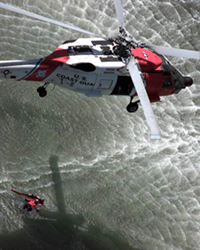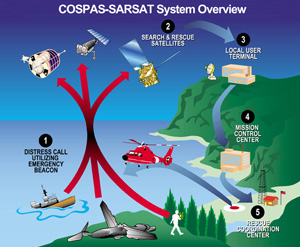NOAA Satellites Helped Rescue 283 People in 2008
Emergency Beacons Switch Exclusively to 406 MHz Frequency Next Month
January 28, 2009
NOAA satellites were key factors in the rescues of 283 people throughout the United States and its surrounding waters in 2008. In each incident, NOAA satellites detected and located a distress signal from an emergency beacon and relayed the information to first responders on the ground.
“With every rescue made, a tragedy was avoided,” said Mary E. Kicza, assistant administrator for NOAA Satellite and Information Service. “Each year NOAA satellites show their versatility by helping us forecast the weather, learn more about our environment and contribute to these life saving rescues.”
NOAA’s polar-orbiting and geostationary satellites, along with Russia’s Cospas spacecraft, are part of the international Search and Rescue Satellite Aided Tracking system, called COSPAS-SARSAT. This system uses a network of satellites to quickly detect and locate distress signals from emergency beacons on board aircraft and boats and from handheld personal locator beacons.
When a satellite finds the location of a distress signal within the United States or its surrounding waters, the information is relayed to the SARSAT Mission Control Center at NOAA’s Satellite Operations Facility in Suitland, Md. From there, it is sent to a Rescue Coordination Center, operated by either the U.S. Air Force, for land rescues, or the U.S. Coast Guard, for water rescues.
2008 SARSAT Rescue Highlights
- Two people were rescued near Port Aranas, Texas, when their disabled boat was swamped by 12-foot waves.
- An injured hiker was rescued after using his personal locator beacon while hiking in a remote area near Hemet, Calif. The rescue became even more challenging when mountain lions were spotted nearby.
- A pilot was rescued about 70 miles southeast of Galena, Alaska, after his Cessna plane crashed into trees.
- Alaska topped the list for the most saves in the United States, with 49 lives rescued in 2008. Rounding out the top five states were: New Jersey, with 18 rescued; Florida, with 15 rescued; Hawaii, with 14 rescued; and California, with 12 rescued.
Older Beacons must be Replaced
Starting on Feb. 1, 2009, NOAA satellites will only receive signals from the new 406 MHz frequency beacons. The older emergency beacons, operating on the 121.5 and 243 MHz frequencies, will no longer be detected by SARSAT. Signals from the 406 MHz beacons can be detected instantly, are more accurate, and offer global coverage. NOAA has provided advance notice of the switch since 2000.
“It’s vital that anyone with the old 121.5 MHz beacon make the switch to 406 MHz beacons immediately so their distress signals can be heard,” said Chris O’Connors, program manager for NOAA SARSAT. “Plans for this changeover started in 2000 and we want everyone that relies on these devices to have the proper equipment.”
Now in its 27th year, COSPAS-SARSAT has been credited with supporting more than 24,000 rescues worldwide, including 6,045 in the United States and its surrounding waters.


